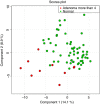Volatile organic compounds emitted from faeces as a biomarker for colorectal cancer
- PMID: 30828825
- PMCID: PMC6593415
- DOI: 10.1111/apt.15140
Volatile organic compounds emitted from faeces as a biomarker for colorectal cancer
Abstract
Background: Colorectal cancer remains a leading cause of mortality and morbidity. The UK Bowel Cancer Screening Programme (BCSP) has demonstrated that detection of colorectal cancer at an earlier stage and identification of advanced pre-malignant adenomas reduces mortality and morbidity.
Aim: To assess the utility of volatile organic compounds as a biomarker for colorectal neoplasia.
Methods: Faeces were collected from symptomatic patients and people participating in the UK BCSP, prior to colonoscopy. Headspace extraction followed by gas chromatography mass spectrometry was performed on faeces to identify volatile organic compounds. Logistic regression modelling and 10-fold cross-validation were used to test potential biomarkers.
Results: One hundred and thirty-seven participants were included (mean age 64 years [range 22-85], 54% were male): 60 had no neoplasia, 56 had adenomatous polyp(s) and 21 had adenocarcinoma. Propan-2-ol was significantly more abundant in the cancer samples (P < 0.0001, q = 0.004) with an area under ROC (AUROC) curve of 0.76. When combined with 3-methylbutanoic acid the AUROC curve was 0.82, sensitivity 87.9% (95% CI 0.87-0.99) and specificity 84.6% (95% CI 0.65-1.0). Logistic regression analysis using the presence/absence of specific volatile organic compounds, identified a three volatile organic compound panel (propan-2-ol, hexan-2-one and ethyl 3-methyl- butanoate) to have an AUROC of 0.73, with a person six times more likely to have cancer if all three volatile organic compounds were present (P < 0.0001).
Conclusions: Volatile organic compound analysis may have a superior diagnostic ability for the identification of colorectal adenocarcinoma, when compared to other faecal biomarkers, including those currently employed in UK. Clinical trial details: National Research Ethics Service Committee South West - Central Bristol (REC reference 14/SW/1162) with R&D approval from University of Liverpool and Broadgreen University Hospital Trust (UoL 001098).
© 2019 The Authors. Alimentary Pharmacology & Therapeutics Published by John Wiley & Sons Ltd.
Figures




Comment in
-
Editorial: metabolomic biomarkers for colorectal adenocarcinoma and in the differentiation between irritable bowel syndrome and ulcerative colitis in clinical remission-confounded by the gut microbiome?Aliment Pharmacol Ther. 2019 Apr;49(8):1086-1087. doi: 10.1111/apt.15171. Aliment Pharmacol Ther. 2019. PMID: 30920041 No abstract available.
-
Editorial: metabolomic biomarkers for colorectal adenocarcinoma and in the differentiation between irritable bowel syndrome and ulcerative colitis in clinical remission - confounded by the gut microbiome? Authors' reply.Aliment Pharmacol Ther. 2019 Apr;49(8):1087-1088. doi: 10.1111/apt.15196. Aliment Pharmacol Ther. 2019. PMID: 30920048 No abstract available.
-
Letter: improving detection of colorectal cancer using two-stage investigation process-faecal immunochemical test and urinary volatile organic compounds.Aliment Pharmacol Ther. 2019 Jun;49(11):1459-1460. doi: 10.1111/apt.15278. Aliment Pharmacol Ther. 2019. PMID: 31074900 No abstract available.
References
-
- Ferlay J, Steliarova‐Foucher E, Lortet‐Tieulent J, et al. Cancer incidence and mortality patterns in Europe: estimates for 40 countries in 2012. Eur J Cancer. 2013;49:1374‐1403. - PubMed
-
- Rees CJ, Bevan R. The National Health Service Bowel Cancer Screening Program: the early years. Expert Rev Gastroenterol Hepatol. 2013;7:421‐437. - PubMed
-
- Trueman P, Lowson K, Chaplin S, et al. Bowel cancer services: costs and benefits. 2007.
-
- Corley DA, Jensen CD, Marks AR, et al. Adenoma detection rate and risk of colorectal cancer and death. N Engl J Med. 2014;370:2541. - PubMed
Publication types
MeSH terms
Substances
Grants and funding
LinkOut - more resources
Full Text Sources
Other Literature Sources
Medical
